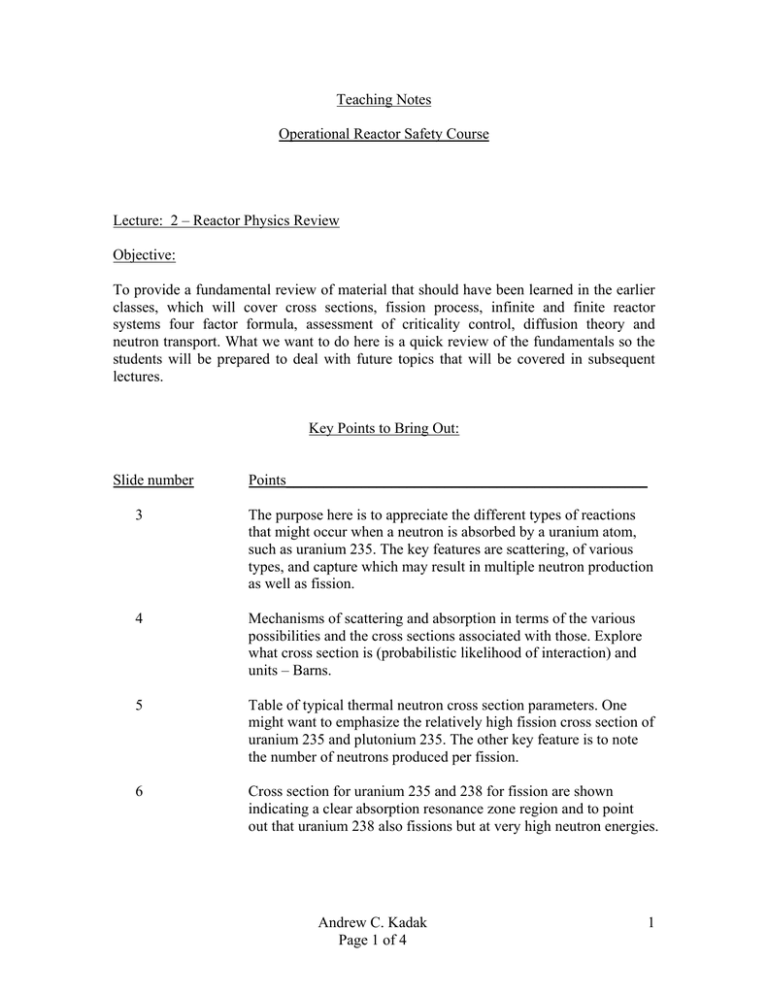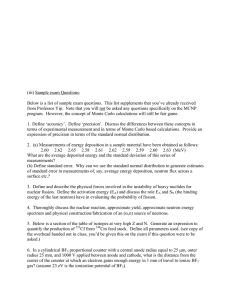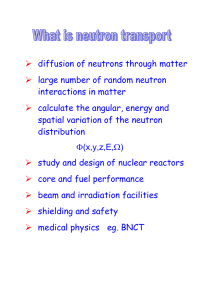Teaching Notes Operational Reactor Safety Course
advertisement

Teaching Notes Operational Reactor Safety Course Lecture: 2 – Reactor Physics Review Objective: To provide a fundamental review of material that should have been learned in the earlier classes, which will cover cross sections, fission process, infinite and finite reactor systems four factor formula, assessment of criticality control, diffusion theory and neutron transport. What we want to do here is a quick review of the fundamentals so the students will be prepared to deal with future topics that will be covered in subsequent lectures. Key Points to Bring Out: Slide number Points________________________________________________ 3 The purpose here is to appreciate the different types of reactions that might occur when a neutron is absorbed by a uranium atom, such as uranium 235. The key features are scattering, of various types, and capture which may result in multiple neutron production as well as fission. 4 Mechanisms of scattering and absorption in terms of the various possibilities and the cross sections associated with those. Explore what cross section is (probabilistic likelihood of interaction) and units – Barns. 5 Table of typical thermal neutron cross section parameters. One might want to emphasize the relatively high fission cross section of uranium 235 and plutonium 235. The other key feature is to note the number of neutrons produced per fission. 6 Cross section for uranium 235 and 238 for fission are shown indicating a clear absorption resonance zone region and to point out that uranium 238 also fissions but at very high neutron energies. Andrew C. Kadak Page 1 of 4 1 7 The key point is to identify the multiplication of neutrons needed for criticality. A neutron balance for criticality requires a neutron population wherein production equals losses. 8 Typical fission energy spectrum associated with the energy of the neutron upon fissioning. The key point here is to show that most of the neutrons are emitted at a 1-2 mev range with much higher neutron but much lower energies possible. 9 The key point is the total amount of energy released per fission, noting that the fission fragments produce by far the largest amount of energy, and delay radiations in terms of beta and gamma produce the rest for total energy released per fission of approximately 200 Mev in terms of actual heat produced. 10 A typical graphic of the fission product decay chain. The key point here is to show that upon fissioning with a certain group chain of fission fragments, there is a decay leading to stable isotopes. 11 Shows the approximate fission yield in terms of fission products produced as a result of the splitting of the uranium atom which yields a roughly equal distribution of isotopes indicated by the two peaks of atomic mass number. 12 Sample chart of the nuclides. Time should be spent on this particular chart by explaining what each of those symbols mean on the table so that the students learn how to use this chart of nuclides to identify the decay chains, the half lives, as well as the relationship between each of the radioactive isotopes and the stable isotopes in the chart. 13 A typical decay chain that you could use to further amplify the processes by which isotopes, either by neutron absorption, or decay, transform themselves into other isotopes. This is important for the students to understand so that they can learn how to move about the chart of the nuclides. 14 There is a process by which fertile, which means non-fissioning isotopes, can become fisile on neutron capture and subsequent decay. The case shown here is thorium and uranium 238. 15 This is a key slide because is takes some of the fundamentals of reactor physics and begins to convert them in terms of what is important relative to power production and that is reaction rates which is related to how we make power. The message here would be focused on using the fission process and the energy release per Andrew C. Kadak Page 2 of 4 2 fission to create heat which then must be removed by the coolant. In determining how to accomplish this mission one must consider certain factors when designing a core, such as, how long do we want to design the reactor in terms of times between refueling. This affects the initial enrichment. Establish the refueling strategy such as online, Full batch, 1/3 core, etc which define how the core is designed in terms of reactivity swing. 16 In thermal reactors, we need to slow down the neutrons. We need to take neutrons born in fast (at high energies) and scatter them down to an energy level where the neutrons are in the thermal energy range at which they are more effective at fission. 17 Shows a typical curve for cross section as a function of energy that should give the students an appreciation of the need to slow down for fissioning. 18 Addresses the types of moderators that can be used to provide the slowing down function that with a note that hydrogen and carbon are very efficient moderators for slowing down because this causes the neutrons to lose more energy per collision. 19 Introduces simple diffusion theory for infinite and finite systems. Calculations for infinite systems use the factor formula and the finite systems need to consider leakage from the reactor. 20 Shows the chart of how neutrons are born and lost. I suggest start tracking at initial fission neutron and follow the cycle clockwise being sure that the students appreciate the production and lost processes. 21 A more detailed graphical illustration showing some of the more essential terms that are involved but it is essentially a repeat of the past slides with more detail. One of the key points here is to take the 6 factor formula and show how the population of fast neutrons are lost, and thermalized between each generation. 22-24 Simple definitions of the terms used in previous slides for reference. 25 Explains neutron lost mechanisms. Key point here is associated with the scale of the likelihood of loss in reactor in a sense of the thermal neutron could escape from the reactor. The other losses are obviously absorbers, by capture in structural materials, and coolant. 26 Key point is to identify how criticality is maintained once the reactor is started up with excess reactivity in terms of higher Andrew C. Kadak Page 3 of 4 3 enrichment, burnable poisons (neutron absorbers) use of control rods and soluble boron. Make the destinction between PWRs (soluble boron) and BWRs (no soluble boron but use of burnable poisons in fuel and control rods for reactivity sump control). Mention online refueling systems such as pebble bed or CANDU reactors require little excess reactivity to compensate for burnup. 27-28 An introduction to diffusion theory for one group and multi-group considerations. The key points here to make are that the material buckling which will be defined in class notes for the blackboard as will be the geometric buckling, which is simply a function of the geometry of the reactor, need to be equal for a critical system. Shown on slide number 28 are the material bucklings for typical geometries. 29 Introduces the notion of multi group calculations, the key point here is to show the importance of selecting the appropriate number of groups to be sure that import phenomenon are captured in terms of neutron cross section for that group distribution. This selection will affect the results of the criticality calculations. 30 Shows normalized flux versus distance or certain geometric conditions which are approximately are about the same basic cosine shapes. 31 Compares one versus two group diffusion theory results and shows the quite different flux distributions for fast and thermal energy groups a two group core with a reflector. 32 Identifies a typical sequence for a Monte Carlo calculation. This is described generally in the Knief book, but the key point to make here is that in Monte Carlo, each neutron is tracked as a function of energy, direction and position. The neutron is tracked in terms of interactions and absorption such as fission or scattering. Neutrons are tracked by number, energy and location. A tally is kept to determine whether the reactor is critical, in terms of neutron population for each generation. 33 The Boltzmann equation is introduced, neutron transport. This equation is useful since it provides an instructive tool on some of the more interesting aspects of neutron interaction and neutron balance as a function of time. Andrew C. Kadak Page 4 of 4 4 MIT OpenCourseWare http://ocw.mit.edu 22.091 / 22.903 Nuclear Reactor Safety Spring 2008 For information about citing these materials or our Terms of Use, visit: http://ocw.mit.edu/terms.








